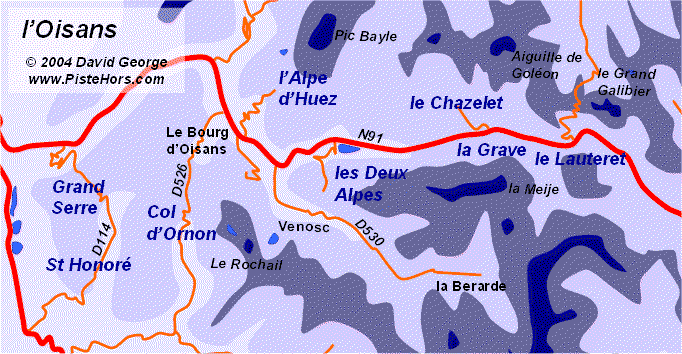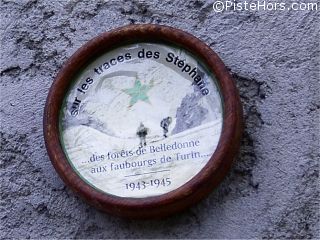
Ski Areas > Northern Alps > Oisans
From Grenoble the river Drac flows eastwards eventually joining the Romanche in one of the six deep valleys that penetrate into the Oisans area. Although the area has seen tourism for over 150 years it remains much less developed than the valleys of the Savoie. Beyond Bourg d'Oisans the main highway was only recently improved and widened to two lanes. The Romanche valley prospered in the later Victorian era with the arrival of hydroelectric power (l'houille blanche). Eight generator plants were in operation and they even supplied Grenoble with electricity. The cheap electricity powered foundries in the villages of Livet, Gavet and Rioupéroux. In 1894 a railway line was built to Bourg d'Oisans.
The nationalisation of electricity in 1946 meant that local factories no longer had an advantage and they gradually declined, today an aluminium foundry survives in Rioupéroux. The building of the Grandmaison dam above Allemont enabled the community to fund the development of skiing and links with l'Alpe d'Huez although at the expense of some excellent off-piste routes.

The first known British tourist to the region was Francis Ford Tuckett who arrived in 1862 however it was Whymper and the Reverend Coolidge who opened the area to climbers. Coolidge, in the company of his Swiss guide Christian Almer roamed the area for 17 years and made dozens of notable first ascents including the Rateau and the Ailefroide. On the 17th of July 1873 they climbed the Agneaux by the 45° by the Calotte route. Almer climbed the 4082 meter Barre des Ecrins in the company of Edward Whymper. These climbs are still considered challenges by today's alpinists.
Climbing Le Rochail we came across a little plaque celebrating the Compagnie Stephane. The steep valleys and high cols of the Oisans were considered ideal territory for the Maquis, the French resistance. The group was under the command of Etienne Poitau (codename Stéphane), born in 1919 he had trained at the elite Saint Cyr officer school near Paris. After the Armistice he joined the resistance in 1942 and after a year in the Auvergne formed a resistance company in the Oisans. Involved in many sabotage operations and ambushes the group numbered 69 members by August 1944. Composed of alpinists from Jeunesse et Montagne as well as refugies the group was incorporated into the French army after the liberation of Grenoble on the 29th August, 1944.

The plaque clearly shows two skiers climbing to a snowy pass. Etienne Poitau died in 1952 during the Indochine war.
The Romanche valley was the scene of a bloody retreat by German soldiers stationed at Briançon. On the 11th of August, 1944 they executed 6 members of the resistance on the col du Lautaret. Heading towards Gremoble the took the whole male population of Villar d'Arêne above la Grave hostage (40 years later this village was still so depopulated a friend was offered a house by the mayor if he moved there). 5 of these hostages and a German soldier were killed by a mine at la Grave. On the 14th and 15th of August resistance members, hostages and Jewish refugees were executed in Bourg-d'Oisans.
High Speed Train to Grenoble from Paris (3 hours). There is a regular VFD bus service to many of the ski areas and to Bourg d'Oisans and Briançon. There are a number of car hire firms situation at the Grenoble railway station. After problems with one firm we advise renters to make sure returned cars are physically checked by a staff member.
Lyon Saint-Exupery and Grenoble St Geoirs (GNB) airports have scheduled flights.
The Isère department web site has traffic information including the state of the road passes. In winter you will need special equipment if you drive beyond Bourg d'Oisans.
http://www.isere.equipement.gouv.fr/infostrafic/routes38.htm
<< Mont-Blanc | Northern Alps | Tarentaise >>